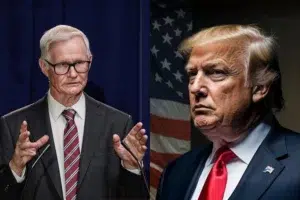Tesla’s Future Under Trump: Will Energy Policies Boost or Challenge Its Growth?
![]() Ujjwal Maheshwari, January 27, 2025
Ujjwal Maheshwari, January 27, 2025
The future of Tesla, a national electric vehicle sector player, will surely change under government policy initiatives. During the Trump administration, an agenda supporting domestic oil, gas, and coal development brought uncertainty into the EV market, with policies shifting focus away from addressing energy resources. This article discusses the influences these policies can have on the growth prospects, market position, and surrounding environmental goals for Tesla.
A New Era of Energy Policies
The energy agenda the Trump administration put forward concentrated largely on the promotion of domestic oil, gas, and coal industries. While this “energy dominance” policy seemed a regime’s response to strengthen traditional energy sectors, it raised questions about implications for companies such as Tesla, relying precisely on those policies incentivising the adoption of renewable energy.
Debate Over the EV Tax Credit
One of the paramount policy changes in the Trump administration will be the potential abolition of the existing federal $7,500 credit for electric vehicle purchases, which for many years has largely acted to tail consumers as a method of making purchase prices more accessible. Without such an incentive, it is feared that consumers and sellers may again fluctuate, driving an upsurge in the price tag for Tesla and consequently causing a slowdown in the adoption of electric vehicles in the U.S.
The discontinuation of the EV tax credit would, in particular, negatively affect the price-sensitive buyers looking to purchase electric cars. The Model 3 and Model Y, crucial to Tesla for gaining in market share, would be scarred the most. While Tesla has cut down manufacturing costs through the years, government cap-off would put Tesla vehicles in an unfavourable market position relative to both gasoline-fuelled cars and other makers of electric cars operating in countries where large cash incentives were offered.
Deregulation of Environmental Standards
President Trump’s rollback of fuel efficiency regulations and other environmental standards is not without repercussions for Tesla. The current administration’s watering down of the CAFE standard has reduced pressure on the car industry to produce fuel-efficient or zero-emission vehicles. Short-term advantages should accrue to car manufacturers in their race for profits over innovation. This is where the deregulation paints a grim picture for Tesla.
Since Tesla cars are already compliant with stringent emission standards, proving their embodiments of the theory of environmentalism in practice, the deregulatory measures may weaken the competitive standing of the company. These rollbacks would dilute the motivation of consumers to switch from gasoline to electric vehicles as the urgency to do so would have been lessened by weaker environmental regulations.
Focus on Fossil Fuels
Another layer of complexity for Tesla comes from the Trump administration’s defining commitment to fossil fuels, including the subsidisation of coal and oil industries. By favouring fossil fuel production, this government has placed an indirect lid on the growth of solutions based on renewable energy. The subsidisation of oil and gas production can lower prices paid for fuel, making internal combustion vehicles more attractive to cost-sensitive car buyers.
Potential Challenges for Tesla
A shift in attitude toward EVs is a potential threat to Tesla’s growth since it was a beneficiary of a friendly attitude toward the promotion of renewable energy and EV technology. The Trump administration has since posed several challenges affecting Tesla’s pace.
Reduced Consumer Demand
Elimination or reduction of the tax credits set up for EVs would offer Tesla cars less financial allure than would a traditional gasoline-powered car. Tesla’s most plentiful and potent vehicle models, the Model 3 and Model Y, are severely affected by shifts in price against various others competing within the mid-market. Without governmental incentives, innovation in manufacturing techniques and supply chain efficiencies will be of paramount importance to Tesla.
Alternatively, in a situation without federal incentives at its disposal, it might have to rely on state-funded programs, like California’s zero-emission vehicle (ZEV) mandate, as a means to foster demand growth. However, this disjointed state-by-state nature of incentives might not be very effective and potentially leave Tesla subject to policy change on a more localised basis.
Market Uncertainty
The disappearance of the prioritisation given to renewable energy within some policy frameworks, particularly in the United States, might dampen investors’ will to keep allocating resources toward the mentioned effort. Tesla has thus far depended on a supportive policy framework to keep its leadership position concerning any in the sector. Some investors are likely to only give off-the-chart growth any thought as long as enthusiastic government backing is given on green energy proposals.
Market uncertainty extends beyond consumer demand. Lack of federal investment in EV infrastructure such as a charging network may slow down expansion in Tesla’s Supercharger network. Weak infrastructure on EVs may deter potential buyers from wanting to invest in the vehicle, thus further slowing Tesla’s growth prospects.
Global Competitive Pressure
While the United States is buying its interests towards traditional energy, countries like China and those in the European Union are doubling down on renewable energy and EV incentives. Tesla may find itself at a disadvantage domestically, but in the long term, it may overcome that by focusing more on international markets that have more favourable policy frameworks. The aggressive adoption targets for EVs by China and subsidies being offered to EV manufacturers made China especially conducive for Tesla’s domestication.
The Green Deal of the European Union along with strict emission rules enhances the feasibility of Tesla’s growth. However, reliance on international markets over purely domestic ones introduces other risks, including currency fluctuations and trade tensions.
Opportunities Amidst Challenges
Even with the challenges, Tesla’s innovative business model and good standing across the globe allow for adaptation in an excellent way. Here are a few, through their strength, a way into a developing market.
Expanding International Markets
These countries, starting from China and the EU, have shown commitment towards ambitious renewable energy goals. The access to government incentives from the home of self-driving and electric vehicles like Tesla would grant Tesla a buffer against an expected slowdown from the U.S. The establishment of Gigafactory Shanghai offers unparalleled criticality to Tesla’s strategy; by manufacturing cars locally, the automaker lowers costs and qualifies for local subsidies. Both of these benefits not only fortify the company’s position in the world’s largest EV market but also provide a model for expansion into other emerging markets.
Vertical Integration
Tesla owning everything from battery manufacturing to producing renewable energy solutions gives it a wild card in competitive advantage. This vertical integration means that Tesla could cut costs, raise efficiency, and remain invincible to policy fluctuations. For example, Tesla’s work in battery technology, along with its 4680 cells, may cut production costs and/or help improve vehicle performance, thus making its EVs desirable even without tax incentives.
It just so happens that Tesla’s energy storage products Powerwall and Megapack extend the company’s reach into the grid-scale energy storage market, which is tipped to be a growth area. These products represent a broader diversification for the company as global trends have moved toward renewable energy adoption.
The Possibilities of Diversification Beyond EVs
Tesla can unlock enormous growth opportunities with its solar panel and energy storage energy division. After all, as consumer and business adoption of clean-energy solutions increases, Tesla’s possible aim could be to find new revenue branches beyond electric vehicle sales. This solar energy sector represents a long-term growth opportunity while remaining affected by the tariffs imposed upon it by the Trump administration.
Tesla’s solar roof product remains relatively in its early stages; however, it seems to be an interesting take on residential solar installation by marrying the generation of solar energy to energy storage. Thus, the company provides a good value proposition to ecologically conscious homeowners.
Conclusion
Tesla’s outlook under a Trump-led government on energy policy is one of challenges and opportunities. The probable elimination of the EV tax credit and the deregulated environmental agenda could hamper better domestic growth, but with its international market coverage and innovative business model, it is poised to meet these challenges.
Investors and stakeholders will, therefore, want to keep an eye on policy developments regarding the potential implications for Tesla and the broader EV sphere. The next four years will see the U.S. government’s approach to energy continue to evolve; Tesla’s ability to adjust and disrupt this market landscape will be a key determinant in its continued market leadership efforts and the global transition toward sustainable energy.
While acknowledging these uncertainties in the environment for policy, Tesla remains a beacon of hope in the fight against climate change, innovation, and sustainability. By exercising its global presence and diversified product-line approach, Tesla can foster the widespread adoption of renewable energy solutions and deliver a cleaner and greener future for present and future generations.
What are the Best ASX Stocks to invest in right now?
Check our buy/sell tips
FAQs About Tesla and U.S. Energy Policies
- How would the removal of the EV tax credit negatively impact Tesla?
The removal of the prior incentive against the payment of tax might mean that Tesla finds its cars costlier, thus affecting those models with the most cost sensitivity, such as the Model 3 or Model Y.
- Will deregulated environmental policies hurt Tesla’s growth?
Yes. Deregulation could decrease how frantically consumers are willing to switch to electric vehicles, creating a less welcoming environment for clean energy companies like Tesla. Luckily for Tesla, its strong presence abroad may help mitigate those effects.
- What steps can Tesla take to adapt to policy changes?
Tesla should focus on scaling up its international presence, work on vertical integration to cut costs, enhance and expand its renewable energy operations, and diversify revenue.
- Are other countries supporting EV growth more than the U.S.?
Yes, countries like China and EU member states actively incentivise EV adoption through subsidies, stricter emission regulations, and investment in renewable infrastructure.
- How does Tesla’s focus on innovation help it navigate policy challenges?
Tesla’s focus on innovation, like battery technology and autonomous driving technology, keeps it relevant and appealing to consumers despite the headwinds created by the government rules.
Blog Categories
Get Our Top 5 ASX Stocks for FY25
Recent Posts
Trump vs. Jerome Powell: What Happens to the Market If Powell Is Fired?
The relationship between President Donald Trump and Federal Reserve Chair Jerome Powell has often been tumultuous, particularly around decisions regarding…
Telix Pharmaceuticals (ASX:TLX): It’s made ~A$1.7bn in revenue from Illucix, but here’s why the best is yet to come!
What would you have thought if you were told 5 years ago you would see Telix Pharmaceuticals as a successful…
Anti Woke ETFs: Do they practice what they preach and have they outperformed since Trump’s return to power?
Have you ever heard of so-called ‘Anti Woke ETFs’? If you’re sick of companies that are big on ESG, this…



